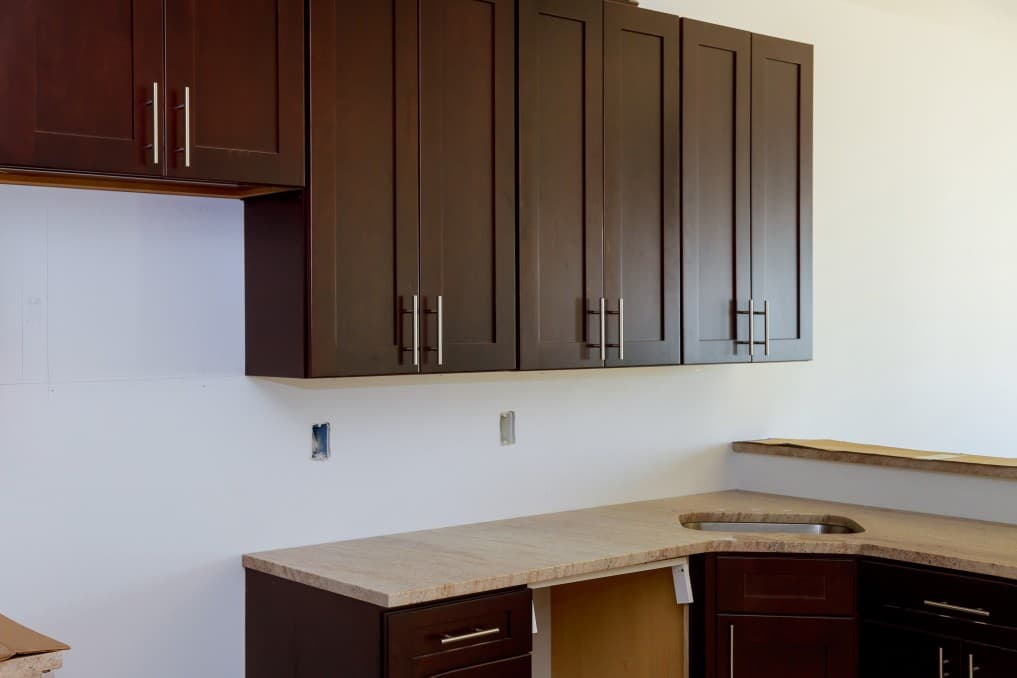Learning how kitchen cabinets are installed may seem difficult at first but the procedures are simpler than you may think. It’s like securing a series of boxes to a wall and to one another in the correct order.

If your cabinet layout is correct, your main task will be to determine the best starting point and maintain levelness.
Transforming your kitchen to something more stylish and suited to your taste also does not need to be such an expensive venture.
There are some materials you may already have at home or even borrow from family and friends.
How Are Kitchen Cabinets Installed Just Like a Professional
This article will answer your most commonly asked questions regarding the installation of kitchen cabinets, tell you what materials you need, and give you a step-by-step guide to help you get your dream kitchen.
This article will answer the following questions:
- What materials do I need?
- How are kitchen cabinets installed?
- How do I install kitchen cabinets?
- How do I find an installer?
Materials you need
- Level
- Measuring tape
- Carpenter’s pencil
- Screwdriver
- Cordless drill/driver
- Stud finder
- Clamps
- Cabinets and molding
- Drywall screws
- Cabinet screws
- Ledgers
- Shims
- Bolts
Pre-installation Guidelines for Kitchen Cabinet Installation
Before we answer “how are kitchen cabinets installed?”, there are some first few steps that are crucial to the process.
-
Measure your space
When thinking about how to install kitchen cabinets, it’s not just drilling and mounting screws. It takes a lot of precise measurement.
You must measure the space before installing kitchen cabinets in order to create a plan for your new cabinetry. To the outside of the molding, measure the walls, doors, and windows.
You’ll also need to take measurements from the floor to the windows, the bottom to the top of the windows, and the top of the windows to the ceiling.
As you go, make a note of any plumbing, gas, or electric lines on your drawing.
-
Remove existing cabinets
If there are already cabinets in the room, you’ll have to take them out. Turn off the kitchen’s electrical, gas, and plumbing/water supply lines.
Disconnect and remove your appliances after removing the doors and drawers from your cabinets. Remove the existing cabinetry’s sink, countertop, molding, and toe kicks.
Finally, unscrew the backs of the cabinetry and back out the screws in the face frames.
-
Prepare your kitchen
Double-check your surroundings before installation. Is there anything wrong with the walls or floors that need to be fixed?
Now is the time to address them while the cabinets are out of the way. You may want to refinish your floors or replace them entirely.
Repair any holes in the walls by patching and smoothing them. Then, paint the area with a couple of coats of paint.
Patching holes in the walls is also much easier with the cabinets out of the way.
Finally, are there any loose ends to tie up before installing cabinets, such as plumbing or electrical? If so, these should be addressed before proceeding.
This is the time to lay new flooring in the area where you’ll be installing cabinets. It will be possible to extend the flooring beneath the new cabinetry if it is installed now.
If you’re putting in a floating floor, there’s an exception. Start with the cabinets and work your way to the cabinet fronts with the flooring.
How are kitchen cabinets installed?
Once your space is ready, carefully and precisely measure the layout for your new space. Simply use the old cabinets as a guide if you aren’t straying from space’s current layout.
Alternatively, you could create your new space using a template from a design center. This step is necessary in either case to ensure that the cabinets you’ll be installing will fit in your space.
When taking measurements, remember to include appliances like your stove and refrigerator, as well as your range hood if you’re installing upper cabinets.
It’s a good idea to leave the appliances in their original locations and measure around them, using them as a guide.
Tip: If you’re putting in a floating floor after the cabinets, make sure they’re higher than the flooring so your appliances can fit under the counters.
Use a piece of flooring and underlayment as a guide to mark the height by placing them on the high spot for easy measuring.
-
Drill the cabinets
Drill holes in the top, middle, and bottom rails of the cabinet backs. The holes in the top and bottom of the cabinet should be about 3/4 inch away from the cabinet’s edge.
Carry out this procedure for each unit.
-
Install Upper Cabinets
So how are kitchen cabinets installed? This is where the challenge begins. Install the upper cabinets first, followed by the lower cabinets.
You won’t have to work over the lower cabinets in a way that might cause damage in the process.
Remove any attached doors and place them out of harm’s way once the cabinets have been assembled according to the manufacturer’s instructions.
Place the cabinet in its proper location and screw the mounting screws into the wall. Make sure the screws aren’t overtightened. Simply tighten them to keep the cabinet in place.
Since the screws are secure, you could raise the cabinet onto the ledger board then double-check the screws to ensure that they can keep the cabinet steady.
Then, make sure it is plumb and level, making any necessary adjustments when needed. You can either add shims or further drive in the mounting screw.
-
Position second cabinets
Pre-drilling could be needed in this step to prevent the hardwood frames from splitting. Shim the cabinet if needed before completely attaching the cabinet to your wall via screws.
Get clamps with rubber padding for added safety then use them to attach the first and second cabinets. Again, watch the screws and do not overtighten them.
Double-check to see if there is a flush line between the installed cabinets. The screws are only there to keep them together.
This is necessary to avoid any gaps from forming between the face frames. If gaps are spotted, a filler bar can be used to close them.
These strips are often provided by the manufacturer, with the most common sizes being 3 inches, 6 inches, and 8 inches.
Do leave some gaps for your essential appliances that need very specific measurements and openings.
Aside from filling up spaces, the filler strips also help create more space for needed equipment.
When assembling cabinets, you can choose to overcut just slightly, then either plane or use a belt-sander for the edge.
-
Install Lower Cabinets
These remaining steps will show you why learning how to install kitchen cabinets can be a great asset and provide answers to “how are kitchen cabinets installed?”
To lighten the cabinets and prevent damage, start by removing all doors, drawers, and shelves.
Lower cabinets are easier to install because you don’t have to hold them in the air, but there are a few more steps to ensure a smooth installation.
Before fastening lower cabinets to the wall, it’s a good idea to make a mockup of the layout. Begin by laying out all of the cabinets except the sink cabinet.
Get a measurement for your plumbing, transfer that measurement to the back of the cabinet, and then cut out the holes with a drill fitted with a hole saw bit or a jigsaw.
Slide the base into place once it’s been cut.
-
Placing the corner cabinet
Starting with a corner, transfer the stud locations to the cabinets with the marks you put on the walls, making sure to take note of the face frame.
Position the corner cabinet in its proper location after you drill the holes. Your main guide will be the line you placed on the wall. Your secondary guide is the mark on the floor.
To make sure it is leveled out, line up the top and shim underneath the base, front, and back.
-
Positioning the second cabinet
The back of the next cabinet should have pilot holes then placed next to the first one.
Even the faces, shim them if needed, then press the cabinet faces together. Screw the back in place with just enough screws to keep it in place.
When you reach the base of the sink, reach for the back and cut the plumbing holes, then put the cabinet together like how you did the others.
-
Attaching the last cabinet
You may have space towards the end of the row. Place the final cabinet properly but do not connect it, then measure the top gap and bottom gap.
Make a mark on the filler strip and cut it out. Fix the filler strip to the frame with a clamp if you have uneven walls.
After scribbling a line with a compass following the contours of the wall, cut at a 7- to 10-degree bevel.
Check the piece’s width and, if necessary, make a mark and cut the cabinet side, or make slight adjustments with a plane.
Drill holes through the frame and lock the filler piece to the cabinet with screws after clamping it flush to the cabinet.
-
Additional attachments
Attach 1-by-2s to the wall with screws if you have spaces with no frames to support the countertop, such as end walls and corner cabinets.
Finish nails are used to cut then, later on, attach the toe kicks. Finish the flooring installation process before moving on to this step if you’re installing a floating floor.
Kitchen Cabinet Installation Final Touches
Finally, reinstall your appliances and add your countertops.
Install the toe kick by cutting it to length with a miter saw and tacking it in place with small finish nails after the appliances are in place.
Once everything is in place, you can finish your kitchen renovation by attaching cabinet doors and installing any necessary hardware.
So how are kitchen cabinets installed? It takes a couple of steps that all involve precision, accuracy, and dedication.
How to Choose a Kitchen Cabinet Installer
Now that we’ve covered how to install kitchen cabinets, let’s talk about the installer.
When it comes to cabinetry for a kitchen or bathroom remodel, the possibilities seem limitless.
Building supply stores, kitchen and bath retailers, and home improvement centers are among the retailers that sell cabinets.
Whether you buy cabinetry from a big box store or a custom cabinet maker, it’s best to hire the same company to measure, design, purchase, and install it.
Kitchen cabinetry can take one day to several months to arrive after being ordered.
Semi-custom orders take about six weeks to arrive, while stock cabinetry is delivered quickly, often the same day.
Custom cabinetry can take up to eight weeks to complete.
Transform the Look & Feel of Your Kitchen
You can transform the look of any room in your home, whether it’s your kitchen, bedroom, bathroom, or even your home office. As long as you have the right tools, know some solid cabinet installation tips, and a little bit of effort.
Knowing how to install kitchen cabinets is a great skill.
When someone asks you, “how are kitchen cabinets installed?”, you’ll know just what to say.
Good Luck in the transformation of your kitchen!
